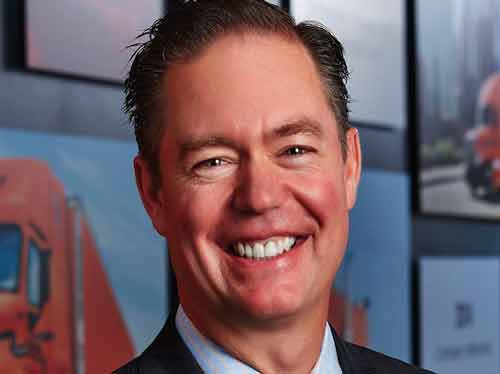Reflecting on 2022, after two and half years of disruption, the transportation and supply chain sector is at a moment to differentiate how we do business and leverage technology to accelerate the industry. Looking ahead to 2023, the opportunity lies before us to deepen strategic relationships with customers and to deliver value.
In my 24 years in the industry at Schneider, I’ve seen several market cycles, and the experience has taught me that it’s those who innovate and adapt in the moment who are successful, and at Schneider, we’re continuously finding new ways to meet the moment, service our customers and invest in our drivers.

The People Who Power Our Industry are Much More Than ‘Essential’
2022 brought attention to the supply chain. Rarely, a day or week has gone by without seeing a mention of the supply chain in the news. We all remember seeing images of the dozens of ships awaiting offload. There’s one upside to the attention: the appreciation and dependence everyday consumers have for the men and women who power supply chains.
Driving is one of the noblest professions in the world. The demand to attract qualified driver candidates has never relented. While the squeeze might be easing, the need to offer high-quality jobs with integrated technology to improve safety and efficiency alongside investing in equipment and opportunities with predictable at home time are vital to creating a place where drivers can build a career.
Supply Chains are Normalizing,and Consumer Spending Hasn’t Fallen Off
In the second half of 2022, overall congestion began to ease and there are demonstrated signs of normalization in the market. The disruption faced by the industry for the last two and a half years, from lack of stock to an inventory surplus as stores over-purchased to mitigate future disruptions, is beginning to get back into sync and next year we will likely see more traditional seasonality when it comes to transportation.
As inflation hit record highs coming out of the summer, it looked as if consumer spending might decline, but the financial health of the American consumer remains strong, and spending has leveled off.

Larger Carriers with Diverse Portfolios Have an Advantage – and Can Offer an Advantage
There was a large influx of small carriers entering the market in 2021 and 2022 during a time when there were not only high spot rates, but high equipment costs as well. As spot rates declined in 2022, these carriers have found themselves under pressure.
Smaller carriers are aligning with larger carriers to try to mitigate some of these challenges. Digital platforms and solutions like Schneider FreightPower® enable this kind of service and make it easier for independent and smaller carriers to book freight for existing trucks. This also provides benefits to customers as Schneider can offer resilient capacity and multi-modal shipping options.
Optimizing Efficiency is Good for Business and the Environment
The rise of environmentally conscious consumers and the potential for government regulation has driven more conversations around reducing emissions. At its core, reducing emissions is increasing efficiency. At Schneider, we continue to integrate emission-friendly business practices such as lightweight tractors to reduce the overall weight, allowing for more cargo to be moved per shipment and reducing the number of loads moved for a given product.
We’ve also invested in technologies and equipment including intermodal containers and chassis to help us not only meet our sustainability goals, but also help our customers meet their Scope 3 emission goals. A single rail container can be shipped 500 miles on the equivalent of a single gallon of fuel. In 2022, we have been working with utility companies and OEMS to design and build the charging infrastructure for our BEV fleet.
Shippers began to realize the benefits of working with carriers like Schneider, which create customized shipping plans and advise on setting sustainability goals. Schneider records, measures, and manages this information and makes it available for customers and stakeholders through an annual Corporate Responsibility Report.
2023: What’s Ahead
Leveraging strong relationships built through the pandemic to weather the market cycle and furthering advancement and incorporation of new technologies are all anticipated for 2023.
The industry will likely experience continued challenges. As highly leveraged carriers begin to exit the market, shippers that are overly reliant on transactional relationships will experience disruptions in their supply chains.
The need for every aspect of the supply chain to work in sync is more apparent than ever, and shippers recognize that diversification opportunities within supply chains will become increasingly important. According to data collected by Schneider, more than 40% of organizations plan to transform their supply chains in 2023. It is beneficial for companies to consider where products are manufactured, how they choose to ship them, where they are stored, and where the product is sold. Carriers, like Schneider, that offer multiple service offerings are able to provide customer solutions that give them value and optionality within an ever-evolving world.
Next year will also bring advancements in technologies such as battery electric vehicles (BEV). Schneider has moved beyond the testing phase, scaling BEV in the company’s Southern California intermodal operations, making Schneider one of the largest electric truck fleets in North America with almost 100 battery electric class 8 eCascadias from Daimler Truck North America. The integration of BEV is an essential milestone for Schneider as we move to reduce carbon emissions per mile by 7.5% by 2025 and 60% by 2035.
Ultimately, a sense of normalcy is returning to the supply chain and world of logistics, although the challenges of the past few years shined a light on companies that could accelerate innovation and customize solutions and transparency to meet the needs of their customers. At Schneider, we’ve survived and thrived through many market cycles in our nearly 90-year history, always emerging stronger than we entered.





